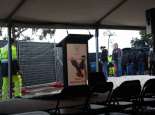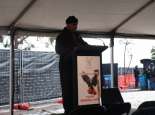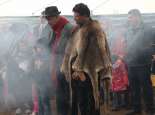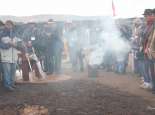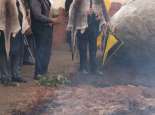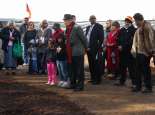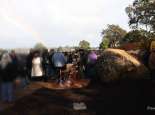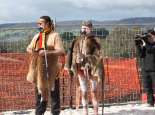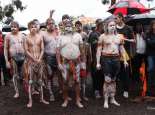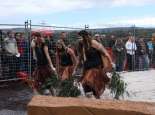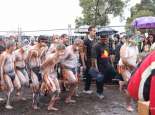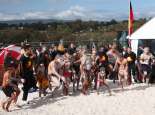Yagan
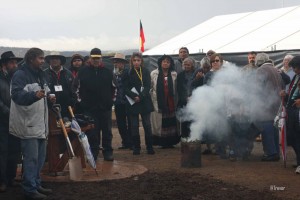 Yagan was born circa 1795 and died sometime in July 1833. He was a Noongar leader and resistance fighter during the early years of the Swan River Colony. In the conflict that ensued, Yagan was both feared and admired by Europeans as a patriot fighting for his land. In today’s Noongar community, Yagan is an iconic figure in the fight for Noongar rights and recognition. The reburial of Yagan’s head was celebrated on the 10th July 2010.
Yagan was born circa 1795 and died sometime in July 1833. He was a Noongar leader and resistance fighter during the early years of the Swan River Colony. In the conflict that ensued, Yagan was both feared and admired by Europeans as a patriot fighting for his land. In today’s Noongar community, Yagan is an iconic figure in the fight for Noongar rights and recognition. The reburial of Yagan’s head was celebrated on the 10th July 2010.
Yagan was a Whadjuk Noongar man. He gained notoriety for his courage and daring in resisting the European settlement of Noongar land. His father was Midgegooroo, another influential Noongar elder often mentioned in The Perth Gazette. Yagan had three brothers; Narral, Billy and Willim (who may also be Weeip).[i] Midgegooroo had more than one wife, and Yagan’s mother may have been Ganiup or an older woman, whose name is not known.[ii]
Between 1831 and 1833, Yagan appeared regularly in the Perth Gazette and the published journals and extracts of the Advocate General George Fletcher Moore. Tall and imposing, Yagan had a ‘distinctive tribal marking on his right shoulder and down his back. He wore a soldier’s old coat under his kangaroo cloak to hide this mark, to avoid recognition by settlers’.[iii] Yagan had a small black dog, which walked with him everywhere.
Early settler portrayals of Yagan register dual attitudes towards the Noongar leader. He was described positively as the ‘daring chief of the tribe’ [iv], but also criticized as ‘the daring villain we have too frequently had occasion to notice’.[v] Hallam and Tilbrook write, ‘Europeans clearly recognised Yagan’s considerable personal charisma, despite, or perhaps because of, his refusal to acknowledge the legitimacy of white power.’[vi]
Early Encounters
Criticisms of Noongar people often reflected a poor or non-existent understanding of Noongar law. Noongars who were ‘stealing’, for example, livestock and other food-sources, were engaging in what they saw as a system of reciprocity. The following series of events led to Yagan becoming an outlaw.
In 1831 Smedley, a servant of homesteader Archibald Butler, shot at a group of Noongar people caught harvesting potatoes and fowls, and killed one of them. [vii] In retaliation, Yagan and Midgegooroo speared another of Butler’s servants.[viii] To the settlers, this act was seen as the unlawful killing of an innocent man. To Noongar people, tribal law required that a member of Smedley’s ‘family-group’ also be killed.
In June 1832, Yagan speared William Gaze who was laboring along the Canning River. Yagan may not have intended to kill Gaze and his death may have been in part due to other factors. [ix] Nevertheless, Yagan was declared an outlaw, a bounty of twenty pounds placed on his head.
It wasn’t until October that Yagan and fellow Noongars, Donmera and Ningina were caught. The men were ‘tricked into a boat’ and eventually taken to the Round House prison in Fremantle.[x] Yagan was saved from execution by the intervention of Robert Lyon, an outspoken settler who had become a defender of the Aboriginal cause’ [xi]. Instead, Yagan and his compatriots were exiled to Carnac Island. After six weeks, the three escaped by boarding an unattended dinghy.
Yagan’s Death
Yagan eluded capture until July 1833 when he was shot by two young shepherd boys on the Upper Swan. Yagan was walking with a group of Noongar maaman, including Heegan when they met up with brothers, William and James Keats, whom they knew. Waiting for the opportune moment, the older brother William took aim and shot at Yagan. When Heegan sprang to his feet, spear in hand, James shot and killed him. In the ensuing fight, William Keats was also killed. His brother later collected the reward for apprehending Yagan and left the Colony for England.
‘Yagan’s head, brutally hacked from his body, was wedged into a hollow tree stump and slowly preserved in the smoke of gum leaves. After several months the lank hair was combed, a band of possum fur string was wrapped around the forehead and a pair of red and black cockatoo feathers added for effect’ [xii]. The head was then taken to England aboard the Cornwallis in September 1833 to be held at the Liverpool Museum.
Yagan’s death had a negative impact on the Swan and Canning River Noongar groups. Without Yagan’s strong personality, Noongar Elders Yellagonga and Munday’s influence was greatly reduced after 1833. [xiii]
Yagan’s Legacy
Yagan remains a significant and legendary figure to Noongar people. He is a symbol of resistance to the European colonization of country and culture.
On the 1st of September 1997, a delegation of Elders brought Yagan’s head or ‘kaat’ back to Noongar country. Hannah McGlade wrote: ‘Old Nyungar men are singing and the clapping sticks can be heard throughout Perth’s international airport late in the night’.’ [xiv]
Reactions to the repatriation were varied, and included racist remarks from the wider media, as well as the vandalism of the statue of Yagan on Heirisson Island.
Now, 177 years after his death, Yagan’s kaat has been reburied in a Memorial Park in the Swan Valley. The Department of Indigenous Affairs granted the City of Swan over $500,000 to develop the ‘Yagan Memorial Park’ to honour the Noongar activist. The reburial was well attended by the Noongar community and included traditional dancing, and a smoking ceremony to purify the area and ward off bad spirits.
Richard Wilkes stated: ‘It is very important because I believe that spiritually, once we rebury Yagan’s kaat into the ground then his spirit will become one again and the spirit of Yagan will rise up in and amongst us” [xv] Yagan Memorial Park Newsletter
Noongar Elder Ken Colbung (RIP), who was instrumental in finding the head and having it exhumed, said:
the spirit of Yagan would now be able to join the continuum and could perhaps live on in a new body. His fighting spirit and stance against injustice should at least live on in our history.
Yagan Memorial Park Newsletter
References
[i] S. Hallam, & L. Tilbrook, Aborigines of the Southwest Region, 1829-1840, UWA Press, 1990, p. 333
[ii] Ibid p. 333.
[iii] Moore G, Extracts p. 282
[iv] The Perth Gazette, March 16th, 1833, p. 43
[v] The Perth Gazette, May 4th, 1833, pp 71-72
[vi] Hallam and Tilbrook, p. 335
[vii] N. Green, Broken Spears: Aborigines and Europeans in the southwest of Australia, Perth p. 79. Also Hallam and Tilbrook, p. 333
[viii] ‘Depositions: Taken Before the Lieutenant Governor and Executive Council at Perth, The Perth Gazette, Saturday May 25th, 1833, p.83
[ix] L. Tilbrook, “Shadows in the Archives: an interpretation of European Colonization and Aboriginal Response in the Swan River Area,” PhD thesis, UWA, 1988, p. 214
[x] Green, p. 80
[xi] Ibid p.80
[xii] Ibid p.88
[xiii] Ibid p.88
[xiv] H. McGlade, “The Repatriation of Yagan: A Story of Manufacturing Dissent”, Law Text Culture (1998) Vol 4, p. 245
[xv] R. Wilkes, 2010 Derbal Yerrigan Chairperson, Yagan Memorial Park Newsletter
